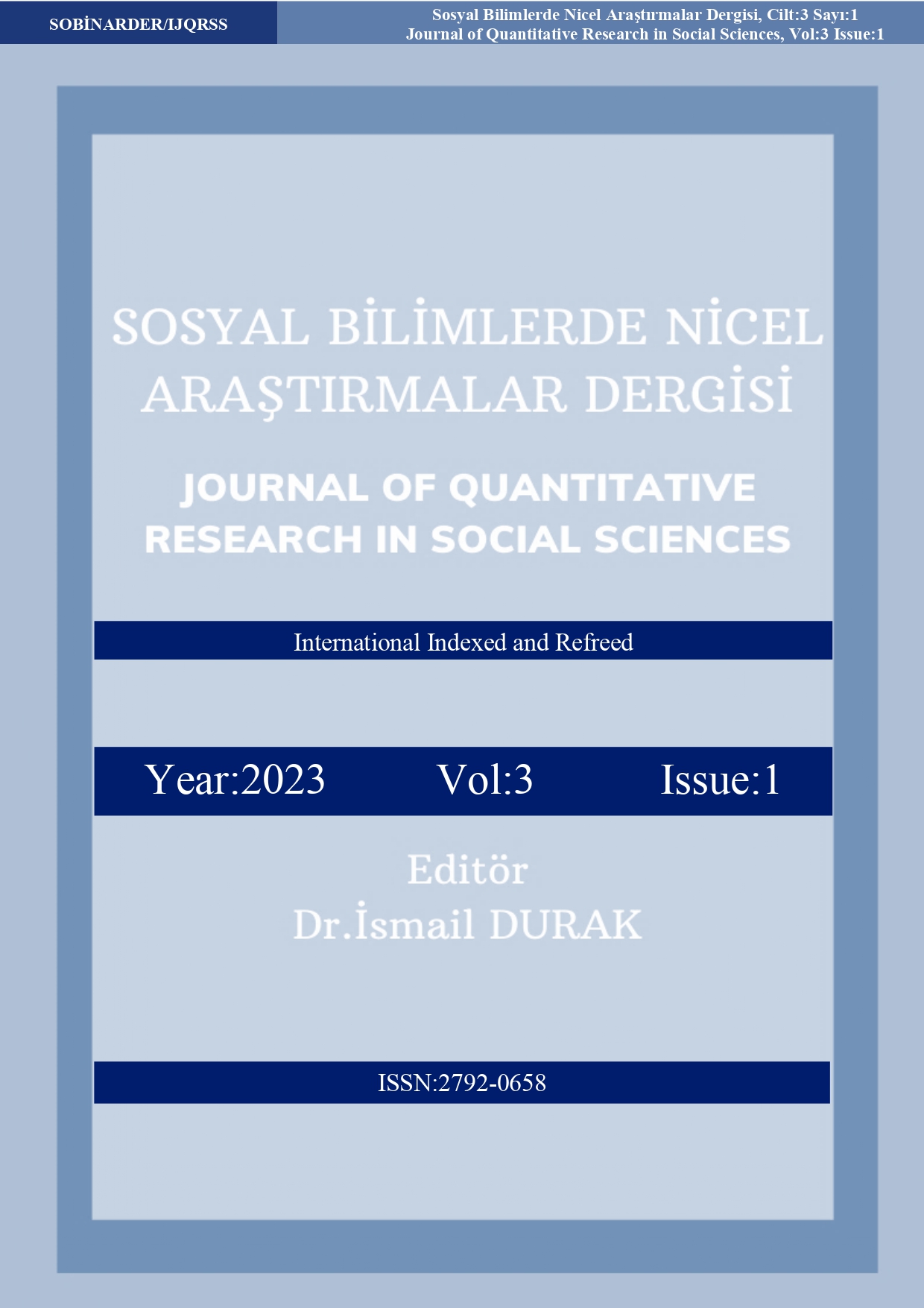The Effects of Inflation and Growth on Unemployment for the Turkish Economy After 1980: The ARDL Approach
Türkiye Ekonomisi için 1980 Sonrasında Enflasyon ve Büyümenin İşsizlik Üzerindeki Etkileri: ARDL Yaklaşımı
Keywords:
Unemployment, Inflation, , Economic Growth, Globalization, Bound TestAbstract
In the 1980s, the Turkish economy entered the liberalization and globalization process in parallel with the trend in the world. The economic policies implemented within the framework of the globalization process gave different results in different countries. The phenomenon of high inflation has become a chronic problem in Turkey in the 1980s and 1990s. Inflation rates, which started to decline after 2002, are still at high levels today. Growth rates followed a fluctuating course and contractions were observed in the economy, especially during the financial crisis. The aim of this study is to investigate the effects of inflation and economic growth rates on unemployment for the Turkish economy after 1980. ARDL Bound Test was used as econometric method in the study. While unemployment is considered as the dependent variable, inflation and growth rates are used as independent variables. As a result of the study, a long-term cointegration relationship was found between the variables. In addition, the long-term coefficients were estimated, and the parameter coefficients related to both inflation and growth rate variables were obtained as negative. In other words, a negative relationship was detected. In the short-term analysis, the error correction model was established and according to the result obtained from the model, it was concluded that the deviations seen in the short-term disappeared in the long-term.
References
Apaydın, Ş. & Taşdoğan, C. (2019). Yapısal ve konjonktürel işsizlik çerçevesinde Okun Yasası üzerine bir gözlem. Uluslararası Yönetim İktisat ve İşletme Dergisi, 15(1), 61-76.
Arı, A. (2016). Türkiye’deki ekonomik büyüme ve işsizlik ilişkisinin analizi: yeni bir eşbütünleşme testi. Siyaset, Ekonomi ve Yönetim Araştırmaları Dergisi. 4(2), 57-67.
Aydın, A. (2021). Türkiye ekonomisinde ithal girdi bağımlılığının analizi, Akademik Yaklaşımlar Dergisi, 12 (2) , 223-249, DOI: 10.54688/ayd.876593
Aykırı M. (2008). Ekonomik büyüme, enflasyon, işsizlik ilişkisi: Türkiye üzerine bir uygulama (1980-2005). Yüksek Lisans Tezi, Kafkas Üniversitesi, Sosyal Bilimler Enstitüsü, Kars.
Bedhaso, A. F. & Jayamohan, M. K. (2020). Nexus between economic growth, unemployment and ınflation in Ethiopia. Proceedings of the Seventeenth International Conference on the Ethiopian Economy, 85- 105.
Bhattarai, K. (2016). Unemployment– ınflation trade-offs in OECD countries. Economic Modelling, 58: 93–103.
Bayrak, M. & Kanca, O. C. (2013). Türkiye’de Phillips eğrisi üzerine bir uygulama. Eskişehir Osmangazi Üniversitesi İİBF Dergisi, 8, 97-115.
Boratav, K. (2015). Türkiye iktisat tarihi, Ankara. İmge Kitabevi
Breusch, T.S. (1978), Testing for autocorrelation in dynamic linear models, Australian Economic Papers, 17, 334-355
Breusch, T.S. & Pagan, A. (1979), A simple test for heteroscedasticity and random coefficient variation, Econometrica, 47, 1287-1294
Brown, R., Durbin, J. & Evans, J. (1975), Techniques for testing the costancy of regression relationships over time, Journal of the Royal Statistical Society Series B, 37, 149-224
Caceres, L. R. (2014). Economic ıntegration and unemployment in Central America. The Journal of Developing Areas, 48(1), 43–60.
Caporale, G. M. & Skare, M. (2011). Employment growth, ınflation and output growth: was phillips right? evidince from a dynamic panel. Economics and Finance Working Paper Series.no:11-09, London: Brunel University.
Chicheke A. (2009). Monetary policy, inflation, unemployment and the philips curve in south africa. Department of Economic Faculty of Management and Commerce University of Fort Hare, 74-96.
Çavdar, T. (2004). Türkiye’nin demokrasi tarihi (1950’ten günümüze). Ankara: İmge Kitabevi Yayınları.
Çil, N. (2018), Finansal ekonometri. Der Yayınları, İstanbul
Dickey, D. A. & Fuller, W. A. (1979), Distribution of the estimators for autoregressive time series with a unit root. Journal of the American Statistical Association, 74(366), 427-431.
Dickey D.A. & Fuller W.A.(1981), Likelihood ratio statistics for autoregressive time series with a unit root. Econometrica, 49(4), ss.1057 1072.
Enders, W. (2010). Applied econometric time series. Third Edition, Wiley, New York
Engle, R.F. & Granger,C.W.J. (1987). Cointegration and error correction: Representation, estimation and testing. Econometrica, 55, 251‐76.
Feibel Bruce, J. (2003), Investment performance measurement, John Wiley and Sons
Friedman, M. (1977), Nobel lecture: ınflation and unemployment, The Journal of Politcal Economy, Vol. 85, No. 3, 451-472.
Godfrey, L. (1978), Testing for multiplicative heteroscedasticity, Journal of Econometrics, 8, 227-236
Godfrey, L. (1978), Testing against general autoregressive and moving average error models When the regressor includes lagged dependent variables, Econometrica, 46, 1293-1302
Göktaş Yılmaz, Ö. (2005). Türkiye ekonomisinde büyüme ile işsizlik oranları arasındaki nedensellik ilişkisi. İstanbul Üniversitesi İktisat Fakültesi Ekonometri ve İstatistik Dergisi, 2, 63-76. http://eidergisi.istanbul.edu.tr/sayi2/iueis2m4.pdf
Gujarati, D.N. & Porter, D.C. (2018), Temel ekonometri, Çevirenler: Şenesen, Ü., Göktürk Şenesen, G., Literatür Yayıncılık, İstanbul.
Gül, E., Kamacı A. & Konya, S. (2012). Enflasyon ile işsizlik arasındaki nedensellik ilişkisinin test edilmesi: panel eşbütünleşme ve nedensellik analizi. Internatıonal Conference on Eurasian Economies 2014. http://avekon.org/papers/861.pdf
Hepsağ, A. (2009). Türkiye’de enflasyon ile işsizlik arasındaki ilişkinin analizi: sınır testi yaklaşımı. İktisat Fakültesi Mecmuası, 59 (1), 169-190. http:// www.journals.istanbul.edu.tr/ iuifm/article/viewFile/1023006579/1023006103
Johansen, S. (1988). Statistical analysis of cointegration vectors. Journal of Economics Dynamic and Control, 12(2-3), 231–254.
Kanca, A. G. O. C. (2012). Türkiye’de işsizlik ve iktisadi büyüme arasındaki nedenselliğin ampirik bir analizi . Çukurova Üniversitesi Sosyal Bilimler Enstitüsü Dergisi, 21 (2), 1-18, Retrieved from https://dergipark.org.tr/en/pub/cusosbil/issue/4390/60351
Kepenek, Y. & Yentürk, N. (2001), Türkiye Ekonomisi (12. Baskı). İstanbul: Remzi Kitabevi
Keynes, J. M. (1936 [2013]). The general theory of employment, ınterest and money, in: A. Robinson and D. Moggridge (ed.), The Collected Writings of John Maynard Keynes, vol. VII, Cambridge University Press, New York.
Kreishan, F. M. (2011), Economic growth and unemployment: an empirical analysis. Journal of Social Sciences. 7(2), 228-231.
Lee, J. & Strazicich, M.C. (2003), Minimum lagrange multiplier. Unit root test with two structural breaks. The Review of Economics and Statistics 85 (4), 1082-1089
Lee, J. & Strazicich, M.C. (2004), Minimum lagrange multiplier Unit root tests with one structural break, Appalachian State University Working Papers, 4/17, 1-15.
Lumsdaine, R. L. & Papell, D. H. (1997), Multiple trend breaks and the unit root hypothesis. The Review of Economics and Statistics. 79: 212-218.
Mucuk, M., Edirneligil A. & Gerçeker, M. (2017). The relationship between unemployment rate and economic growth: the case of Turkey. Siyaset, Ekonomi ve Yönetim Araştırmaları Dergisi. 5(1), 1- 8
Narayan, P.K. & Popp, S. (2010), A new unit root test with two structural breaks in level and slope at unknown time. Journal of Applied Statistics, 37(9), 1425-1438.
Nelson, C. & Plosser, C. (1982), Trends and random walks in macroeconomic time series: Some evidence and implıcations. Journal of Monetary Economics, (10), 139-169
Okun, A.M. (1962), Potential gnp: ıts measurement and significance, reprinted as cowles foundation Paper, 190.
Paya, M. (1998), Para teorisi ve politikası, İstanbul, Filiz Kitabevi.
Perron, P. (1989). The Great Crash, The Oil Price Shock, and The Unit Root Hypothesis. Econometrica 57:1361-1401.
Perron, P. (1997), Further evidence on breaking trend functions in macroeconomic variables, Journal of Econometrics, 80 (2), 355-385.
Pazarlıoğlu, M.V. & Çevik, E.İ. (2007). Ratchet model: 1939-2005 dönemi Türkiye uygulaması. Trakya Üniversitesi Sosyal Bilimler Dergisi, 1, 17-34.
Pesaran, M. H. & Shin, Y. (1995) An autoregressive distributed lag modelling Approach to cointegration analysis. In S. Strom, A. Holly, A. Diamond (eds), Centennial Volume of RagnerFrisch, Cambridge UniversityPress
Pesaran, M.H., Shin, Y. & Smith, R.J. (2001). Bounds testing approaches to the analysis of level relationships. Journal of Applied Econometrics, 16, pp.289- 326.
Phillips, A. W. (1958). The relation between unemployment and the rate of change of money wage rates in the united kingdom, 1861–1957, Economica, London School of Economics and Political Science, vol. 25(100), pages 283-299, November
Phillips, P.C. & Perron, P. (1988), Testing for a unit root in time series regression. Biometrika, 75(2), ss.335 346.
Quattara, B. (2004), Foreign aid and fiscal policy in Senegal, Manchester, Mimeo University of Manchester.
Ramsey, J.B. (1969), Tests for specification errors in classical linear least squares regression analysis, Journal of the Royal Statistical Society B 31, 350-371.
Şentürk, M. & Akbaş, Y. E. (2014). İşsizlik-enflasyon ve ekonomik büyüme arasındaki karşılıklı ilişkinin değerlendirilmesi: Türkiye örneği, Journal of Yasar University, 9, 5820-5832.
TÜİK (2013), İstatistik göstergeler, 1923-2012, Ankara,TÜİK Yayınları
TÜİK (2022), GSYH zincirlenmiş hacim endeksi değişim oranları, Erişim tarihi: 15 Ocak 2023, https://data.tuik.gov.tr/Kategori/GetKategori?p=ulusal-hesaplar-113&dil=1
TÜİK (2023), Tüketici fiyat endeksi, Erişim tarihi: 2 Ocak 2023, https://data.tuik.gov.tr/Kategori/GetKategori?p=enflasyon-ve-fiyat-106&dil=1
TÜİK (2023), Temel işgücü göstergeleri, Erişim tarihi: 15 Ocak 2023, https://data.tuik.gov.tr/Kategori/GetKategori?p=istihdam-issizlik-ve-ucret-108&dil=1
Uslu, H. (2020). İstihdam yaratmayan ekonomik büyüme: Türkiye için Okun Yasası çerçevesinde ekonometrik bir analiz, Optimum Ekonomi ve Yönetim Bilimleri Dergisi, 7 (1), 101-126
Uysal, D. & Savaş, E. (2003). Enflasyon ile işsizlik oranı arasındaki ilişki ve Türkiye örneği (1980-2002). Sosyal ve Ekonomik Araştırmalar Dergisi, 6, 35-47.
Walterkirshen E.(1999). The relationship between growth, employement and unemployement in EU. Austrian Institute of Economic Research, 1-9.
Yıldız, N.,Akduğan, U. & Taşdemir, D. (2017). Relationship of the economic growth and unemployment: an empirical assessment of Okun’s law for Turkey. International Refereed Academic Social Sciences Journal. 25, 61-74.
Yılmaz, G. Ö. (2005), Türkiye ekonomisinde büyüme ile işsizlik oranları arasındaki nedensellik ilişkisi. İstanbul Üniversitesi Ekonometri ve İstatistik Dergisi, 2, 11-29.
Zagler, M. (2003). A vector correction model of economic growth and unemployment in major European countriesand an analysis of Okun's law, Applied Econometricsand International Development. 3(3), 93-118.
Zivot, E. & Andrews, D. (1992), Further evidence on the great crash, The oil-price shock and the unit-Root Hypothesis. Journal of Business Economic Statistics. 10(3): 251- 270
Downloads
Published
How to Cite
Issue
Section
License
Copyright (c) 2023 Journal of Quantitative Research in Social Sciences

This work is licensed under a Creative Commons Attribution-NonCommercial 4.0 International License.
Telif hakkı hakkında










